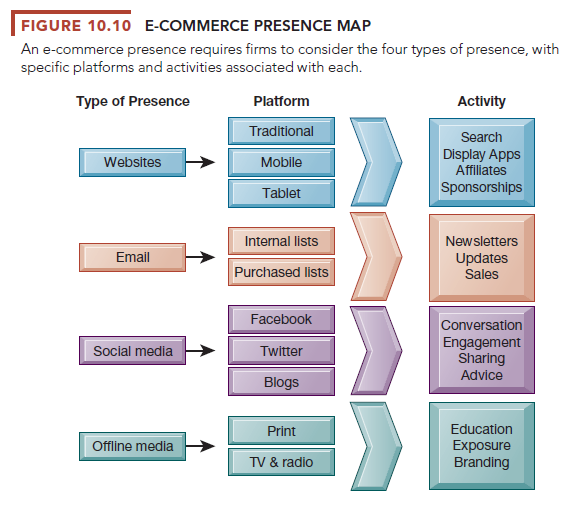Building a successful e-commerce presence requires a keen understanding of business, technology, and social issues as well as a systematic approach. Today, an e-commerce presence is not just a corporate website but also includes a social network site on Facebook, a Twitter feed, and smartphone apps where customers can access your services. Developing and coordinating all these customer venues can be difficult. A complete treatment of the topic is beyond the scope of this text, and students should consult books devoted to just this topic (Laudon and Traver, 2019). The two most important management challenges in building a successful e-commerce presence are (1) developing a clear understanding of your business objectives and (2) knowing how to choose the right technology to achieve those objectives.
1. Develop an E-commerce Presence Map
E-commerce has moved from being a PC-centric activity on the web to a mobile and tablet-based activity. Currently, a majority of Internet users in the United States use smartphones and tablets to shop for goods and services, look up prices, enjoy entertainment, and access social sites, less so to make purchases. Your potential customers use these various devices at different times during the day and involve themselves in different conversations, depending what they are doing-touching base with friends, tweeting, or reading a blog. Each of these is a touch point where you can meet the customer, and you have to think about how you develop a presence in these different virtual places. Figure 10.10 provides a roadmap to the platforms and related activities you will need to think about when developing your e-commerce presence.

Figure 10.10 illustrates four kinds of e-commerce presence: websites, email, social media, and offline media. You must address different platforms for each of these types. For instance, in the case of website presence, there are three platforms: traditional desktop, tablets, and smartphones, each with different capabilities. Moreover, for each type of e-commerce presence, there are related activities you will need to consider. For instance, in the case of websites, you will want to engage in search engine marketing, display ads, affiliate programs, and sponsorships. Offline media, the fourth type of e-commerce presence, is included here because many firms use multiplatform or integrated marketing by which print ads refer customers to websites.
2. Develop a Timeline: Milestones
Where would you like to be a year from now? It’s very helpful for you to have a rough idea of the time frame for developing your e-commerce presence when you begin. You should break your project down into a small number of phases that could be completed within a specified time. Table 10.8 illustrates a one-year timeline for the development of an e-commerce presence for a start-up company devoted to fashions for teenagers. You can also find more detail about developing an e-commerce website in the Learning Tracks for this chapter.

Source: Laudon Kenneth C., Laudon Jane Price (2020), Management Information Systems: Managing the Digital Firm, Pearson; 16th edition.

19 Jun 2021
21 Jun 2021
21 Jun 2021
18 Jun 2021
21 Jun 2021
19 Jun 2021